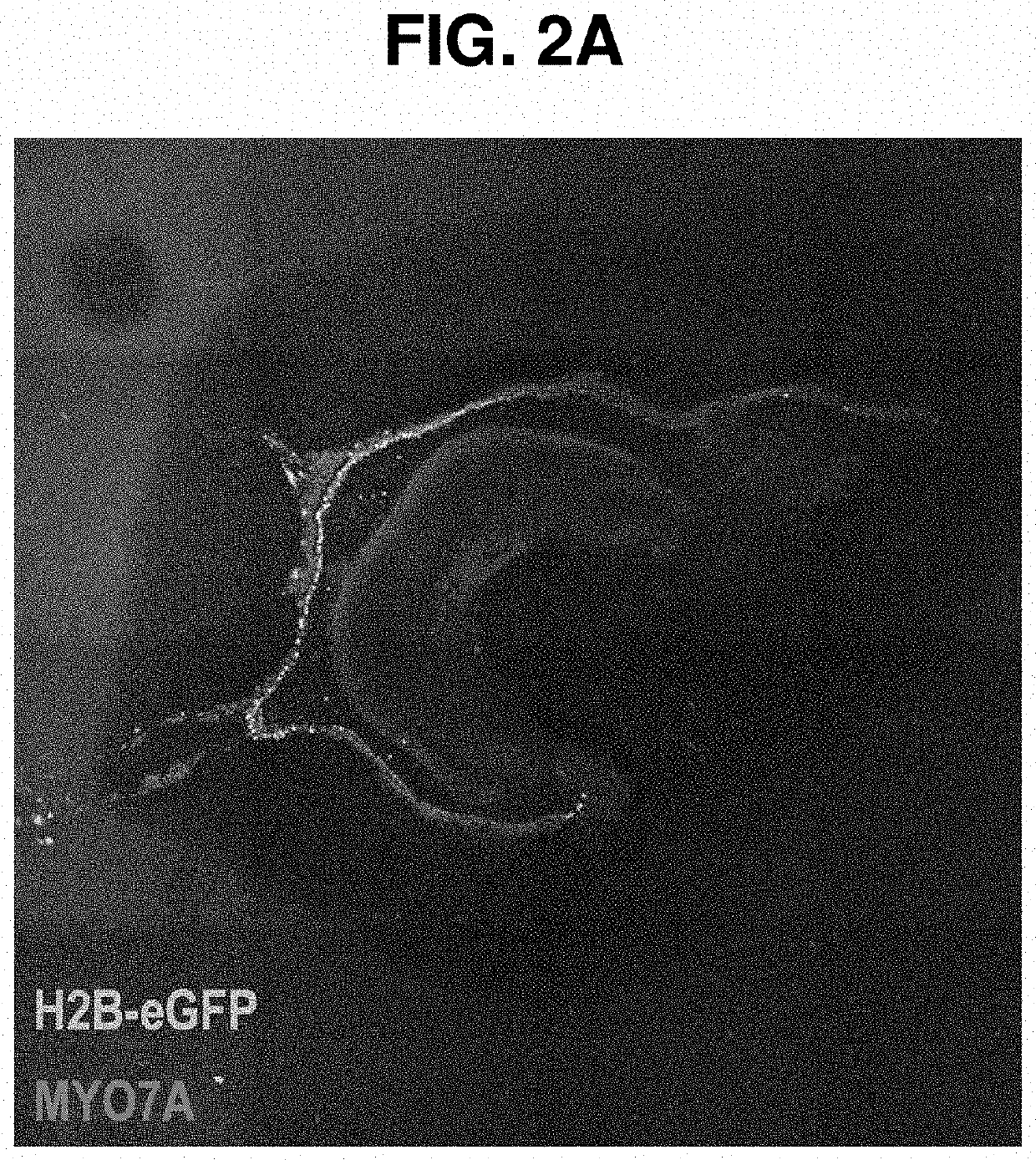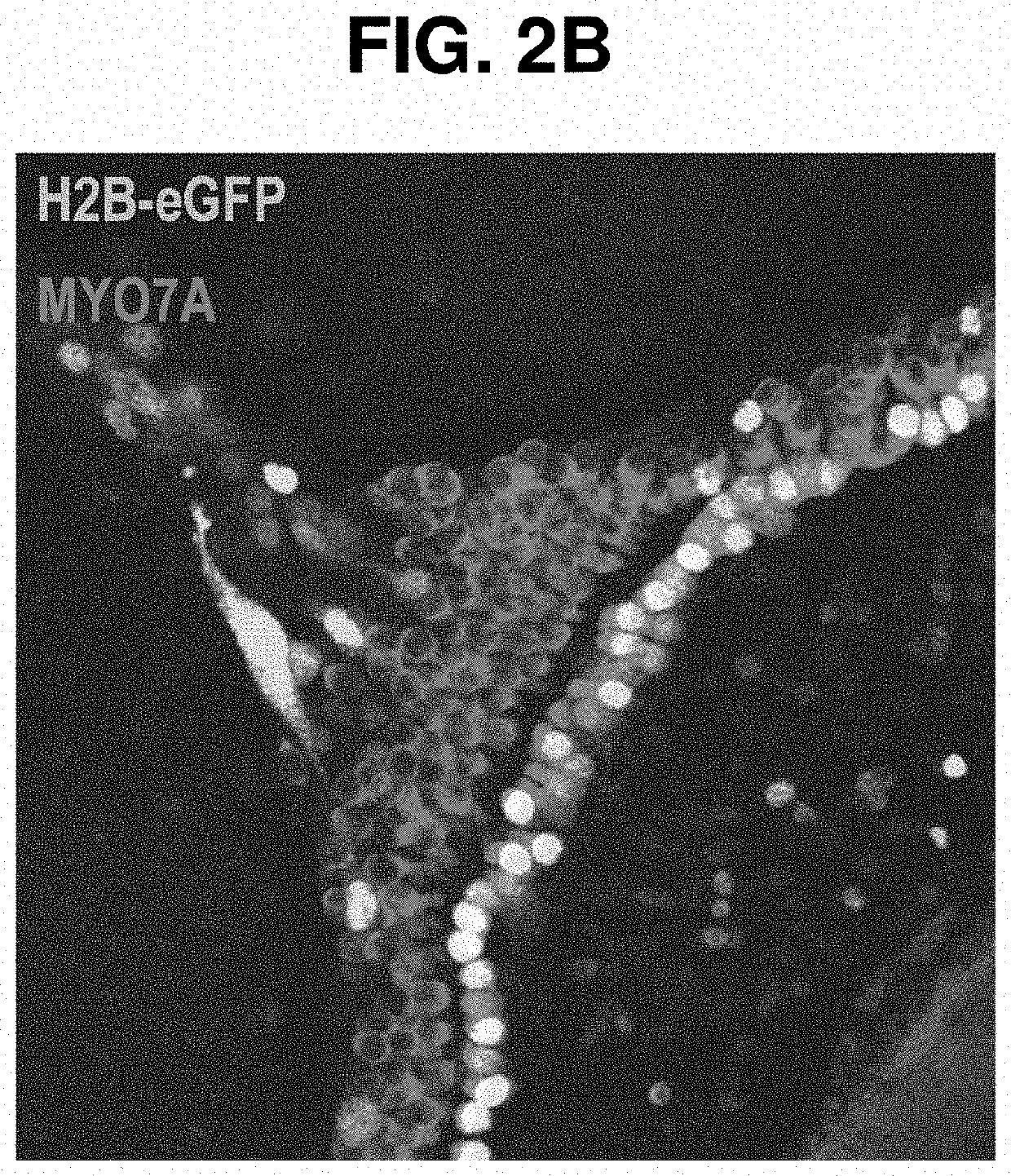Cochlear inner hair cell promoters and uses thereof
a technology of promoters and hair cells, applied in the field of compositions and methods for promoting the expression of a gene of interest, can solve the problem of few approaches to specifically target hair cells
- Summary
- Abstract
- Description
- Claims
- Application Information
AI Technical Summary
Benefits of technology
Problems solved by technology
Method used
Image
Examples
example 1
n of a Murine Calcium Binding Protein 2 (CABP) Promoter
[0109]To facilitate inner hair cell (IHC)-specific expression of exogenous transgenes in a target cell, a murine CABP2 promoter was constructed. A 1526 base pair (bp) regulatory element (SEQ ID NO: 1) was generated by combining genomic regions upstream of the translational start site of the murine CABP2 gene. These regions contain annotated summits of single cell (sc)-Assay for Transposase Accessible Chromatin (ATAC)-sequencing (seq) peaks in hair cells of the cochlea and regions of high mammalian conservation (FIG. 1, black rectangles). In order to generate a promoter fragment that is selectively active in IHCs, the most distal (5′) fragment was extended to include a genomic region with annotated sc-ATACseq peaks for IHCs but not outer hair cells (OHCs) or vestibular supporting cells (FIG. 1, dashed rectangle). The combined genomic regions of the murine CABP2 (1526 bp) promoter fragment (SEQ ID NO: 1) span across 2,257 bp of th...
example 2
moter Sequence Induces Transgene Expression in IHCs in Murine Cochlea In Vitro
[0110]To determine the efficacy of the constructed murine CABP2 promoter (SEQ ID NO: 1) in inducing transgene expression in IHCs in vitro, mouse cochlear explants were prepared from postnatal day 1 (P1) B6 / CAST-Cdh23Ahl+ / Kjn mice. Cultured murine cochlear explants were treated with adeno-associated viral (AAV) plasmids containing the human histone H2B gene fused to a green fluorescent protein (GFP) gene (AAV1-mCABP2-H2B-GFP) at a viral dose of 1×1011 viral genomes (vg) / culture. Explants were incubated for 72 hours, fixed, and immunostained with an anti-Myosin 7a (MYO7A) antibody to label all hair cells and an anti-GFP antibody to measure CABP2 promoter-driven GFP expression. Fluorescence imaging was performed on a Zeiss LSM 780 microscope and displayed as maximum z-projections. GFP expression was observed in specifically in cochlear IHCs (FIGS. 2A-2C). In another set of experiments, cochlear explants were ...
example 3
ation of a Composition Containing a Nucleic Acid Vector Containing a Hair Cell-Specific Promoter to a Subject with Sensorineural Hearing Loss
[0111]According to the methods disclosed herein, a physician of skill in the art can treat a patient, such as a human patient, with sensorineural hearing loss so as to improve or restore hearing. To this end, a physician of skill in the art can administer to the human patient a composition containing an AAV vector (e.g., AAV1, AAV2, AAV2quad(Y-F), AAV6, AAV9, Anc80, Anc80L65, DJ / 9, 7m8, or PHP.B) containing an inner hair cell-specific promoter (e.g., a polynucleotide having at least 85% sequence identity (e.g., 85%, 86%, 87%, 88%, 89%, 90%, 91%, 92%, 93%, 94%, 95%, 96%, 97%, 98%, 99%, or more, sequence identity) to the sequence of any one of SEQ ID NOs: 1-3) operably linked to a transgene that encodes a therapeutic protein. The composition containing the AAV vector may be administered to the patient, for example, by local administration to the ...
PUM
 Login to View More
Login to View More Abstract
Description
Claims
Application Information
 Login to View More
Login to View More - R&D
- Intellectual Property
- Life Sciences
- Materials
- Tech Scout
- Unparalleled Data Quality
- Higher Quality Content
- 60% Fewer Hallucinations
Browse by: Latest US Patents, China's latest patents, Technical Efficacy Thesaurus, Application Domain, Technology Topic, Popular Technical Reports.
© 2025 PatSnap. All rights reserved.Legal|Privacy policy|Modern Slavery Act Transparency Statement|Sitemap|About US| Contact US: help@patsnap.com



